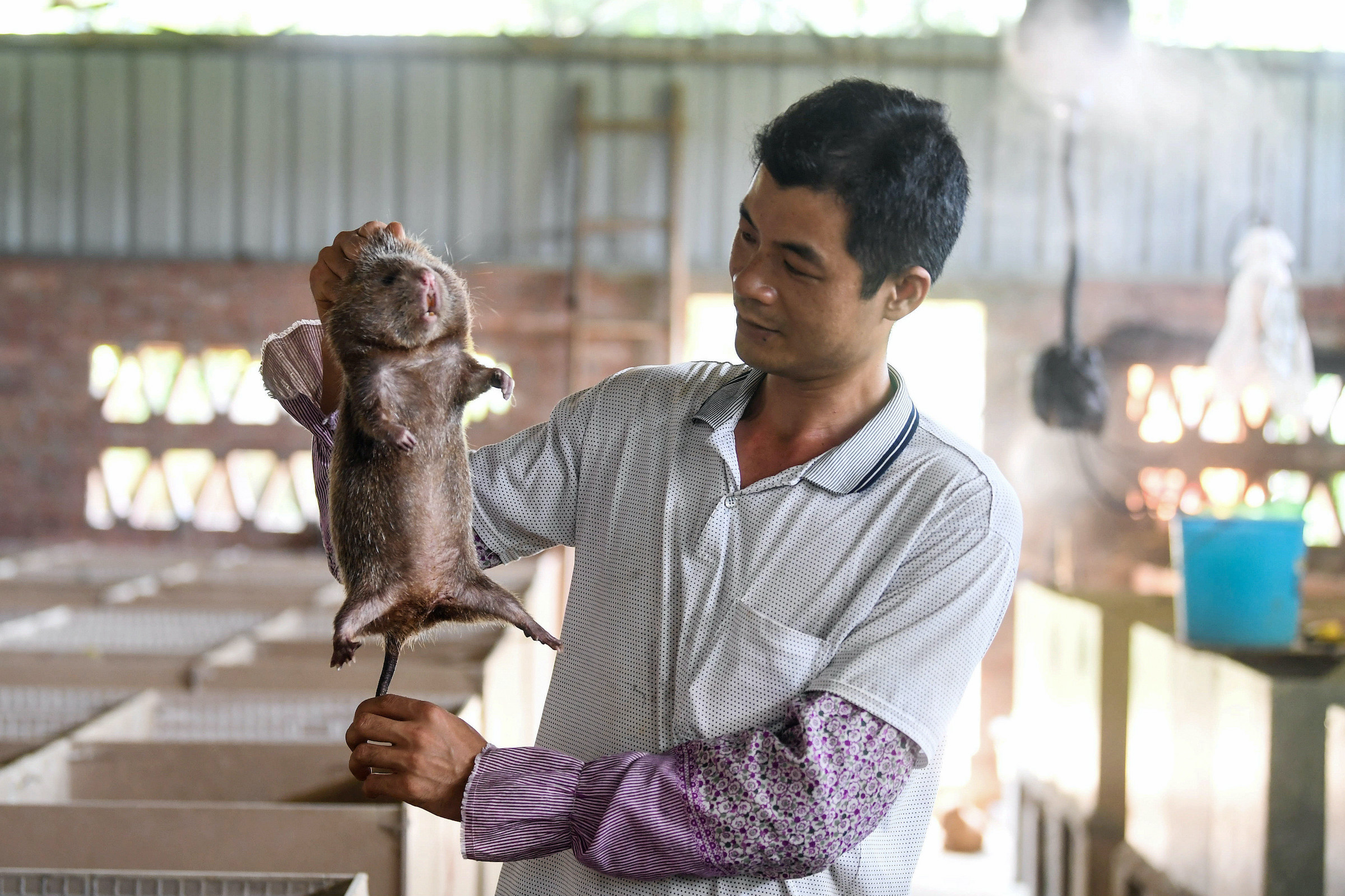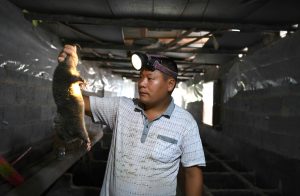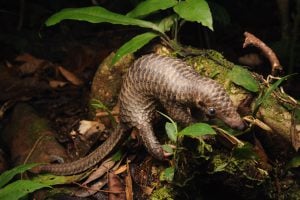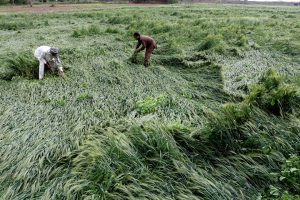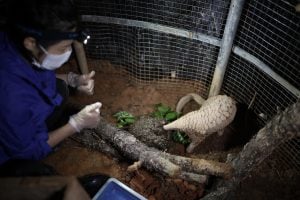Covid-19, and its suspected origin in wildlife consumption, has caused China to look again at how it treats the natural world. With unprecedented public demand for a ban on the eating of wild animals, China’s highest legislative body is moving quickly to avoid a similar public health crisis from happening again.
On 10 February, the Legislative Affairs Commission of the National People’s Congress Standing Committee added a revision of the Wildlife Protection Law to its agenda for 2020. Then to protect public health, the Standing Committee announced on 24 February a “complete ban of illegal wildlife trade and the elimination of the unhealthy habit of indiscriminate wild animal meat consumption”. The decision will allow measures to be taken before the revision of the Wildlife Protection Law comes into effect.
The revised law could change the fate of wild animals not just in China, but worldwide. For over a month, conservation groups and scientists have worked together to propose changes. The variety of the proposals highlights disagreements regarding wildlife protection in China: over aims, methods and interests. But a new consensus is also emerging from the public health emergency. The outcome of the revision process will depend on how the disagreements and the consensus are reflected in the language of the updated law.
China Dialogue has analysed the most influential proposals, listed at the bottom of the article, across four key themes: biodiversity, public health, wild-animal farming and utilisation, and calls for deeper reform.
Restoring biodiversity
The Wildlife Protection Law, which first came into effect in 1988, is the legislative basis for management and protection of wildlife in China. It has been revised four times: in 2004, 2008, 2016 and 2018. But language permitting the “use” of wild animals has always been present, even after the bitter lessons of the 2003 SARS epidemic. A major debate over the 2016 revision centred on whether wild animals should be “used” or “protected”, with the principle of “regulated use” written into the law, consolidating the idea that wildlife is to be treated as a “resource”.
The law, orientated towards use, limits protections to two categories of wild animal: those that are “rare and endangered land and aquatic animals” and those “land wild animals with important ecological, scientific or social value”. The two lists of animals are supposed to be updated regularly. For wild animals not on the lists, the law has no clear rules on their domestication, breeding, trade or consumption.
The China Law Society’s Environment and Resource Law Research Group points out in its proposal that protection of animals not included in either category is currently implemented piecemeal across various laws and regulations, that there are “difficulties in resolving conflict between use and protection, and the protection-first principle cannot be implemented”.
The existing law leaves plenty of scope for the use of wild animals. It establishes a licensing system for artificial breeding of wild animals under special state protection: both the animals and their products can be bought, sold and used if quarantine certificates and approvals are in place. Other animals can be sold and used if they’re acquired legally. In reality, there are numerous issues with licensing, approvals, quarantine inspection and law enforcement.
Meanwhile, local and regional governments promote the farming of wild animals as a way to reduce poverty and stimulate rural economies. Accordingly, the wildlife farm industry has been steadily expanding.
Many animals that should be protected by the current law are not, as updates to the short lists of protected species are long overdue. The SEE Foundation pointed out the problem in its proposal: according to the regulations, the forestry and grassland authorities submit land animals to be listed and the fishery authorities do the same for aquatic animals. Once agreed, the lists are submitted to the State Council for approval. However, the two authorities have failed to reach agreement for some years. Many of the proposed revisions examined by China Dialogue aim to create a scientific mechanism for making these decisions, ensuring the lists are updated regularly and kept in line with international treaties such as CITES (the Convention on International Trade in Endangered Species) and the CBD (Convention on Biological Diversity). This is to ensure that certain animals receive priority protection, whilst more animals acquire protection status through the expansion of the legal definition of “wildlife”.
Taken together, the narrow legal definition of “wild animals”, fragmented oversight mechanisms and the failure to update lists of animals given special state protection means that many animals are not adequately protected, exposing the public to the risk of disease.
Several proposals call for the scope of protections to be widened. In a joint proposal, ten organisations including Shanshui Conservation Centre, Peking University Centre for Nature and Society, and Friends of Nature suggest expanding protections for “wild animals with important ecological, scientific or social value” to cover all as-yet unprotected species as “ordinary protected animals”. The thinking here is to change the current approach of valuing animals according to rarity and utility toward one of protecting biodiversity and acknowledging that all animals have their place in the ecosystem. This “biodiversity principle” features in five of the six proposals examined. Four also call for stronger protection of wildlife habitats to preserve biodiversity.
On this, the China Law Society’s Environment and Resource Law Research Group proposed particular care be taken to ensure the revised law links up with the Nature Reserve Law, The National Park Law, and the Yangtze River Protection Law, all currently being drafted, and the ongoing revision of the Fisheries Law. This would avoid conflict between these laws on how habitats, protected areas and nature reserves are listed, and prevent administrative powers overlapping or conflicting across agencies.
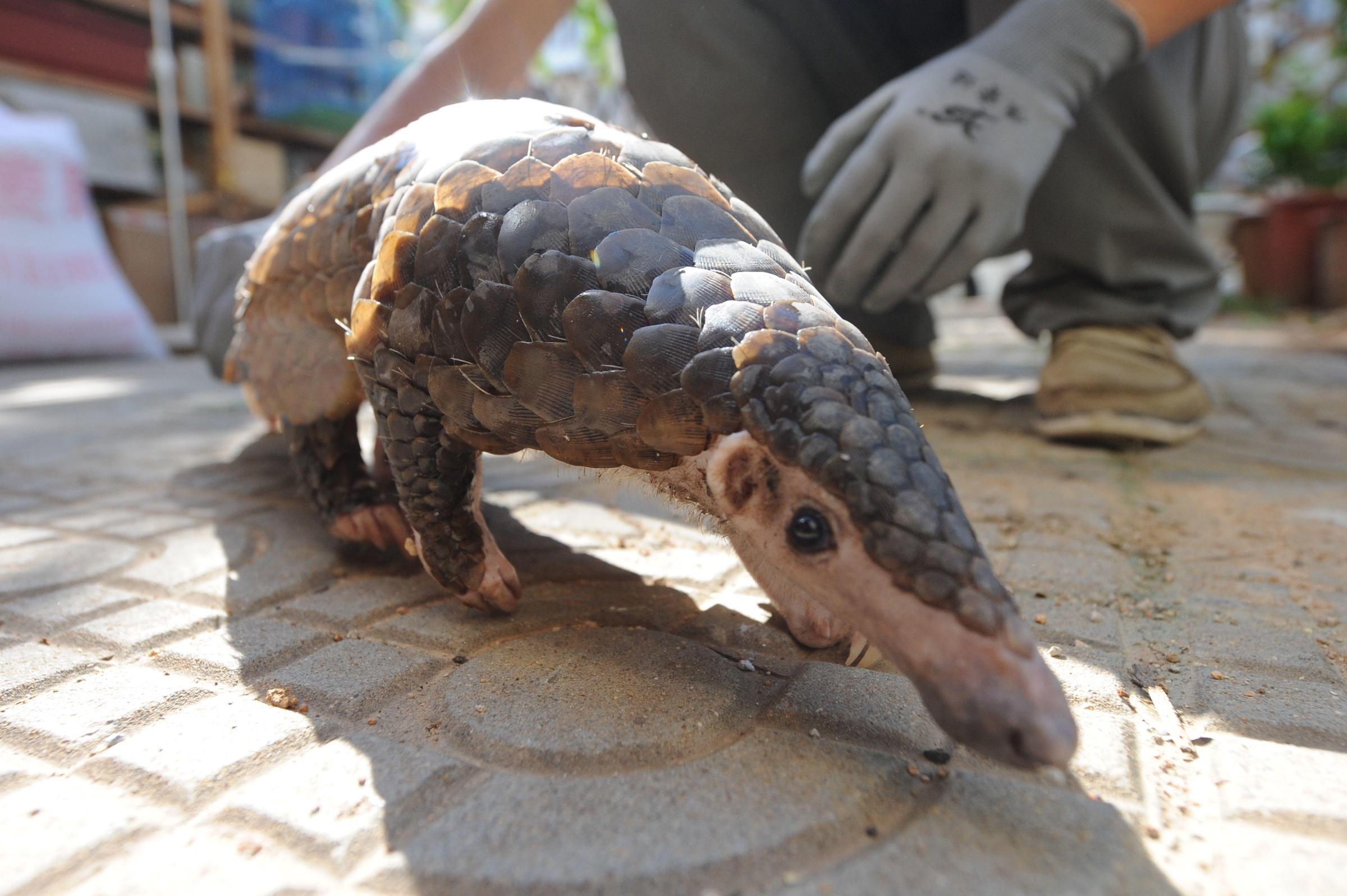
A pangolin to be released back into the wild in southern China is pictured after being rescued in Qingdao, east China. (Image: Alamy)
Protecting public health
With the revision of the law being prompted by concerns about disease, health was a focus of the proposals we reviewed, with each calling for the protection of public health to be included as a purpose of the legislation.
These concerns have brought new ideas on management of wildlife, and, like biodiversity protection, provide motivation to expand the scope of the law. Preventing the spread of disease from the consumption of wild animals was a regular feature of the proposals. The joint proposal from Shanshui Conservation Centre and eight other groups, and the proposal from the China Biodiversity Conservation and Green Development Foundation (CBCGDF), both included a ban on eating wild animals as a first principle. CBCGDF went further, suggesting a ban on domestication and breeding of wild animals.
Public health is also offered as a rationale for habitat protection. The joint proposal from Shanshui et al. suggested, in accordance with a UN assessment, that habitat change can lead to “changes in the number of vector breeding sites or reservoir host distribution”. Therefore, the revised law “should explicitly stress the protection of both wild animals and their habitats, giving habitat protection higher status and designating it as a purpose of the legislation”.
Public health worries have even triggered unusually extreme proposals for bans on eating wild animals at the local level. In late February, the Shenzhen People’s Congress published a consultation draft of rules to ban the eating of captive-bred and raised Chinese softshell turtles, due to the risk of disease. This led to opposition from businesses and huge public debate, until the Ministry of Agriculture clarified that rules for management of aquatic animals still applied.
An immediate halt to medicinal usage was not seen as feasible.
However, policies driven by public health concerns could easily overlook the trade in non-food and sterilised products, such as medicines and ornaments, particularly from animals captured or farmed and then processed from overseas.
In the proposals examined by China Dialogue, all from Chinese organisations, there was little mention of the medicinal use of wild animals. The CBCGDF talks of “cautious use of wild animals”, only “in the public interest of the whole society”. Those interests include medicinal use (alongside scientific research and education). But the proposal also suggests encouraging Chinese medicine manufacturers to develop alternatives, so use of wild animals and wild animal products is reduced and eventually eliminated. Another proposal, from 14 environmental law experts, said that where alternatives are available, a timetable should be set for the reduction and elimination of the use of wild animals in medicine. An immediate halt to medicinal usage was not seen as feasible.
For international conservation groups, banning the medicinal use of wild animals is more pressing.
In late February, the Environmental Investigation Agency (EIA) published its own proposal for the revised law, raising the issue of controlling the use of animals such as the elephant, tiger, pangolin and rhinoceros, and their products. It also called for the law to explicitly ban use of wildlife under special state protection in medicine, health products and ornaments. In 2018, the EIA published a report into the use of leopard bones in Chinese medicine, finding that a 1993 ban on the trade in tiger bones had resulted in widespread use of leopard bones as an alternative. The EIA estimated that more than 5030 leopards – including carcasses and skins – were seized in Asia since 2000, raising this to a minimum of 5332 in a March update to the report. The EIA’s proposal is opposed to the existing dual-track approach of protecting wild populations while making use of captive-bred animals, saying that “Whether wildlife is consumed as food, medicine, a healthcare tonic or as a decorative item, this consumption poses risks to both the conservation of the species and public health”. It therefore says: “the revised Law should make it clear that wildlife consumption of any kind is unacceptable.”
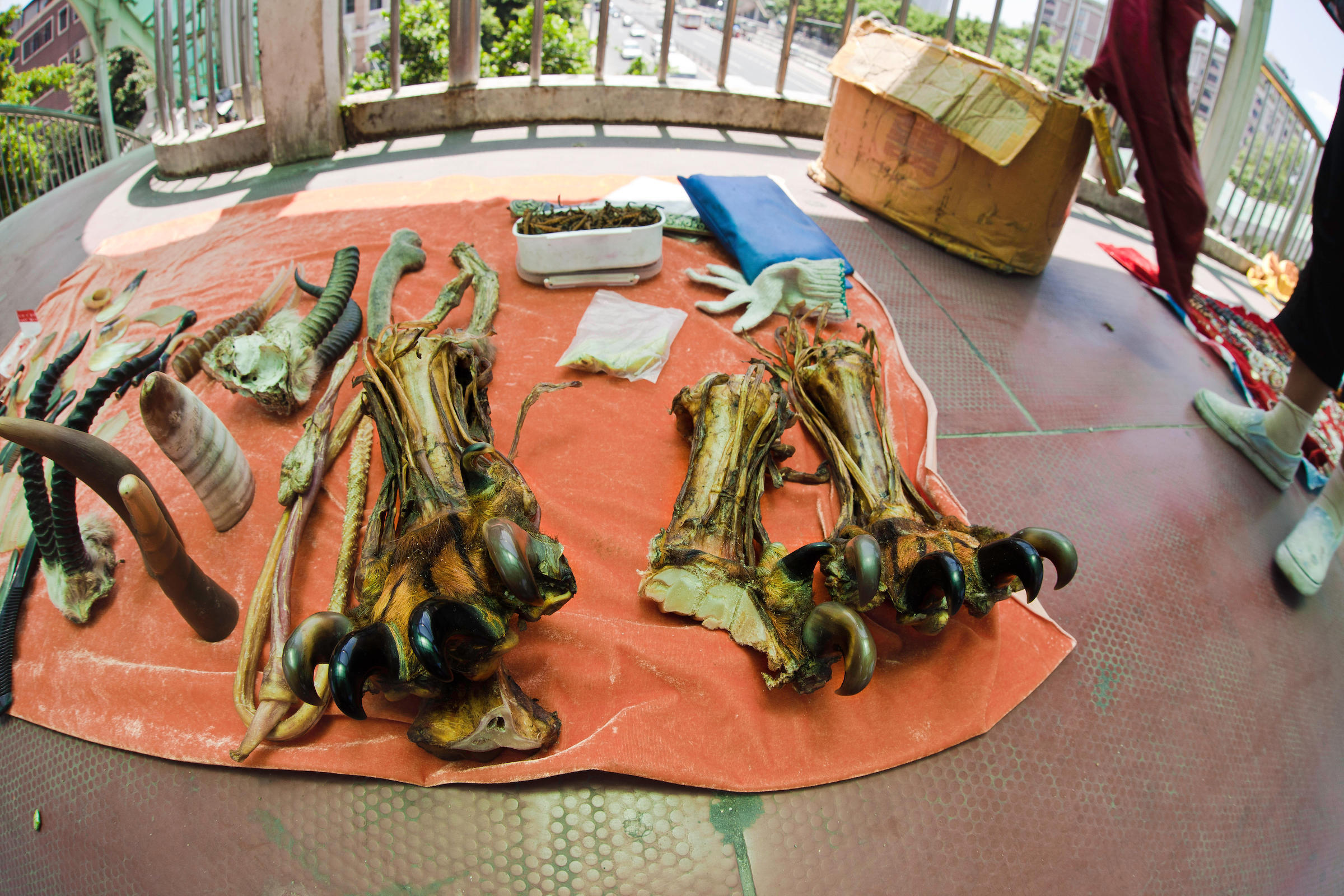
A street seller on an overpass displays tiger paws and animal products for sale in Guangzhou, China. (Image: Alamy)
A related matter, and one which the domestic groups again paid less attention to, is how the law should treat imported wild animal products. Only the proposal from the 14 environmental law experts called for “a ban on the import for food use of captive-bred or wild-caught land wild animals and aquatic mammals, and products of these.” Again, the focus here is on public health and food use.
Aron White, China specialist with the EIA, doesn’t want to see non-food use overlooked. He notes the decision of the NPC’s Standing Committee only bans the trade in wild animals for food, but that if endangered animals around the world are to be protected, there is an urgent need to remove demand for their products from China’s markets.
In a message to China Dialogue, White wrote: “Continuing to allow a legal trade in threatened wild animal species for use in traditional medicine is irresponsible on a global scale – both in terms of legitimising and perpetuating demand for species already under huge threat in other countries due to primarily China-based demand, and the public health risks inherent in the harvesting, collection, storage, processing and consumption of wild animals for any reason.”
A breeding whitelist
The existing law’s resource-utilisation approach means a huge wild-animal farming industry worth hundreds of billions of yuan has developed, providing over 14 million jobs nationwide. Debate has also focused on the tricky issue of how the law should treat that industry.
The CBCGDF has taken the hardest line, calling for a ban on all commercial breeding of wild animals. The other proposals want to see a “whitelist” to regulate and reduction in the practice.
The Shanshui Conservation Centre-led proposal includes the idea of a special whitelist of animals that could be bred in captivity, with offspring permitted to be used for non-food commercial purposes. Alongside this it suggests the use of captive-bred animals as stock for breeding programmes; the maintaining of genealogical data, breeding files and data on individual animals; and traceability of breeding animals with microchips.
The SEE Foundation suggests a more relaxed approach. This would see wild animals reclassified as either “special animals” or “ordinary protected animals”. The first category would be sub-divided into rare and endangered animals to be protected, and wild animals that could be farmed after scientific assessment and under strict controls. The second category would cover all other wild animals. On the utilisation of wild animals, the SEE Foundation calls for “a ban on the illegal eating of wild animals and wild animal products”. The expression “illegal eating” corresponds to its call for a whitelist of wild animals that could be legally eaten. The proposal also makes clear that it “does not exclude the use of wild animals for purposes such as scientific research or fur farming”. But research has found fur farming to be the biggest single sector in China’s wild animal industry.
Despite differing in the broadness of their whitelists, SEE and the joint proposal from the Shanshui Conservation Centre both say quarantine inspections for whitelisted animals must be a priority. Shanshui suggests quarantine standards for a species be a prerequisite for inclusion on the white list; the SEE Foundation admits that the entry criteria of the whitelist will be the key, and that quarantine standards will need to be improved before animals can be listed.
Zhao Xiang, director of the Shanshui Conservation Centre, told China Dialogue that establishing such an animal quarantine system will be difficult, requiring dedicated laboratories, veterinarians, species-specific standards, and careful ongoing management.
But those organisations proposing a whitelist do want to limit and reduce the size of the industry step by step, rather than maintain the status quo. Gradually cutting down the number of animals on the whitelist will send a signal to the industry that it is time to change. “We hope the list will shrink over time,” said Liu Jinmei, chief legal consultant to Friends of Nature, speaking to China Dialogue. She also stressed that great caution should be used in creating the whitelist, and any business unable to meet the standards should exit the industry.
Calls for deeper reform
Several groups pointed out that fixing the inherent contradictions of the existing Wildlife Protection Law, and practical problems in enforcement, will require deeper reform.
The China Law Society’s Administrative Law Research Group proposes changing China’s administrative system for protecting wild animals. It writes that China’s forestry authority has long been responsible for protection of wildlife on land – but that authority has been downgraded over time, from ministerial to bureau status, and lacks the resources to undertake such a complex task. It suggests a new wildlife protection bureau be established under the Ministry of Natural Resources, ensuring the necessary status and resources. The SEE Foundation made a similar suggestion.
The Shanshui Conservation Centre-led proposal pointed out that the forestry and grassland authorities are responsible for protection of wild animals on land, while the Ministry of Agriculture’s fisheries department handles aquatic wild animals – and disagreements between the two have long hampered protection of wild animals in China. It agrees that these functions should be brought under the Ministry of Natural Resources, as above, but adds a supervisory role for the Ministry of Ecology and Environment.
Consolidating administrative powers won’t be enough to ensure protection measures are implemented effectively, as issues with information gathering remain. There are many wild animal species and they exist in large numbers. What’s more, crimes against them are generally well-hidden so more administrative staff and resources alone cannot identify problems. Because of this, several proposals advocate for greater public rights to information on wildlife protection and to exercise oversight of the authorities, which should, in turn, ensure transparency and allow public participation. Both the SEE Foundation and the CBCGDF want to see “public participation” made a principle of the revised law, giving the public and organisations the right to oversight, including to report illegal behaviour and administrative failures, or to expose such cases in the media and bring public interest lawsuits; and for public consultations and hearings to be held when construction projects may damage wildlife habitats.
The Covid-19 pandemic has demonstrated in the starkest of terms how no one country’s biodiversity and wildlife trade policies exist in isolation.
When it comes to public interest lawsuits, Zhao Xiang thinks social organisations will be able to play a positive role in assessing damages and cause and effect in future cases. Meanwhile, Liu Jinmei has seen how such cases have an effect far beyond the matters under discussion in the courtroom, shaking up established interests and power structures. The Environmental Protection Law of 2015 gave social organisations the right to bring lawsuits as representatives of the public interest. This breakthrough has become an important channel for resolving environmental disputes.
But the existing system for environmental public interest lawsuits doesn’t allow cases against government actions. The CBCGDF therefore suggests “establishing a system for social organisations to bring administrative public interest lawsuits”. This would allow these groups to bring cases against the government on matters of wildlife protection and keep power in check. The 2017 revisions of the Civil Procedure Law and the Administrative Litigation Law only allowed for environmental public interest cases against government bodies to be pursued by public prosecutors.
Several organisations also noted that improvements to the Wildlife Protection Law alone will not be enough to improve wildlife protection – coordinated change is needed across several laws.
The China Law Society’s Administrative Law Research Group suggests parallel changes to the articles on wildlife in China’s Criminal Law, and to add a crime of mistreating wild animals.
The SEE Foundation, meanwhile, hopes the revision will expand into a more comprehensive process: “Use the revision of the Wildlife Protection Law as a starting point for ongoing revision of other laws and regulations, departmental rules and local legislation on wildlife protection.” This would see a chain reaction of revisions to regulations on protection of land animals and laws on fishing, animal health, animal import and export, environmental protection, and the civil and criminal laws.
As Aron White commented to China Dialogue: “The Covid-19 pandemic has demonstrated in the starkest of terms how no one country’s biodiversity and wildlife trade policies exist in isolation. The link to wildlife trade in China, whether legal or illegal, shows the urgent need for stronger laws and enforcement to close markets for wild animal products.”
Will this unprecedented pandemic mean the fifth revision of the Wildlife Protection Law is different? We may find out at this year’s Two Sessions (Lianghui) – although those meetings have also been delayed.
Proposals discussed in this article:
- Nine suggestions on the revision of the Wildlife Protection Law. China Law Society Administrative Law Research Group, 12 February.
- 10 key points for the 2020 revision of the Wildlife Protection Law. The SEE Foundation, 17 February.
- Opinions and suggestions on the revision of the Wildlife Protection Law. Peking University Centre for Nature and Society, Shanshui Conservation Centre and eight other groups, 18 February.
- Six legislative suggestions for strengthening wildlife protection, ensuring biosafety and protecting public health. From 14 environmental law experts, including Chang Jiwen, 22 February.
- Several opinions and suggestions on the revision of the Wildlife Protection Law. China Law Society Environment and Resource Law Research Group, 24 February.
- 10 suggestions for the revision of the Wildlife Protection Law. The China Biodiversity Conservation and Green Development Foundation, 24 February.
